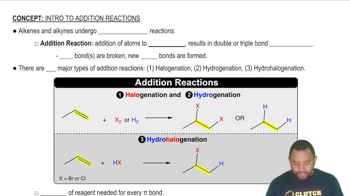Here are the essential concepts you must grasp in order to answer the question correctly.
Electrophilic Addition
Electrophilic addition is a fundamental reaction mechanism in organic chemistry where an electrophile reacts with a nucleophile, leading to the formation of a more saturated compound. In the case of alkenes, the double bond acts as a nucleophile, attacking the electrophilic hydrogen in hydrogen halides, resulting in the formation of a carbocation intermediate.
Recommended video:
Carbocation Stability
Carbocations are positively charged species that form during electrophilic addition reactions. Their stability is influenced by the degree of substitution; tertiary carbocations are more stable than secondary or primary ones due to hyperconjugation and inductive effects. Understanding carbocation stability is crucial for predicting the major products of reactions involving alkenes.
Recommended video:
Intepreting the Band of Stability
Markovnikov's Rule
Markovnikov's Rule states that when a hydrogen halide adds to an asymmetric alkene, the hydrogen atom will attach to the carbon with the greater number of hydrogen atoms already attached. This rule helps predict the regioselectivity of the addition reaction, leading to the formation of the more stable carbocation and ultimately the major product in the reaction with cyclohexene.
Recommended video:

 Brown 14th Edition
Brown 14th Edition Ch.24 - The Chemistry of Life: Organic and Biological Chemistry
Ch.24 - The Chemistry of Life: Organic and Biological Chemistry Problem 40
Problem 40 Verified step by step guidance
Verified step by step guidance


